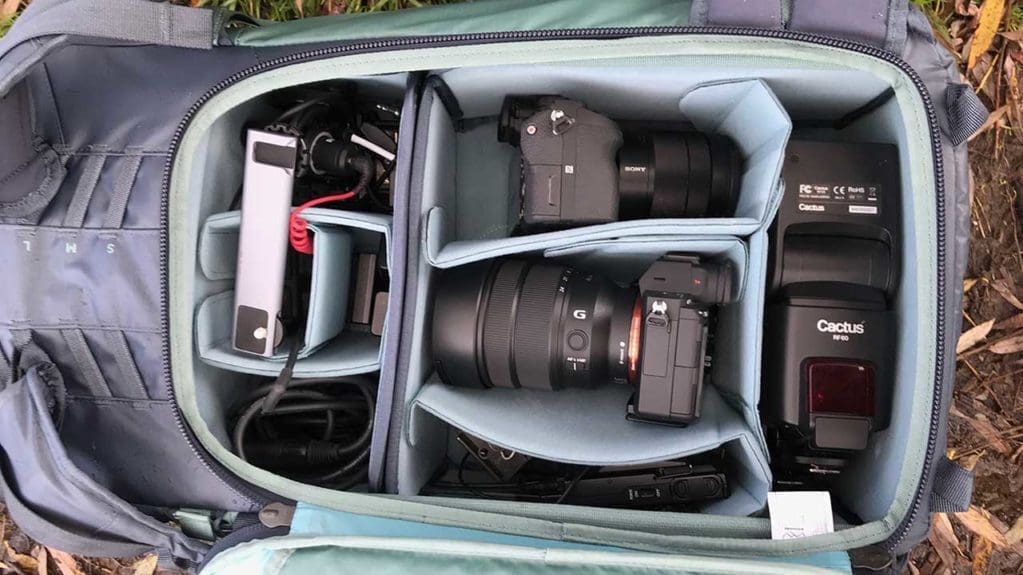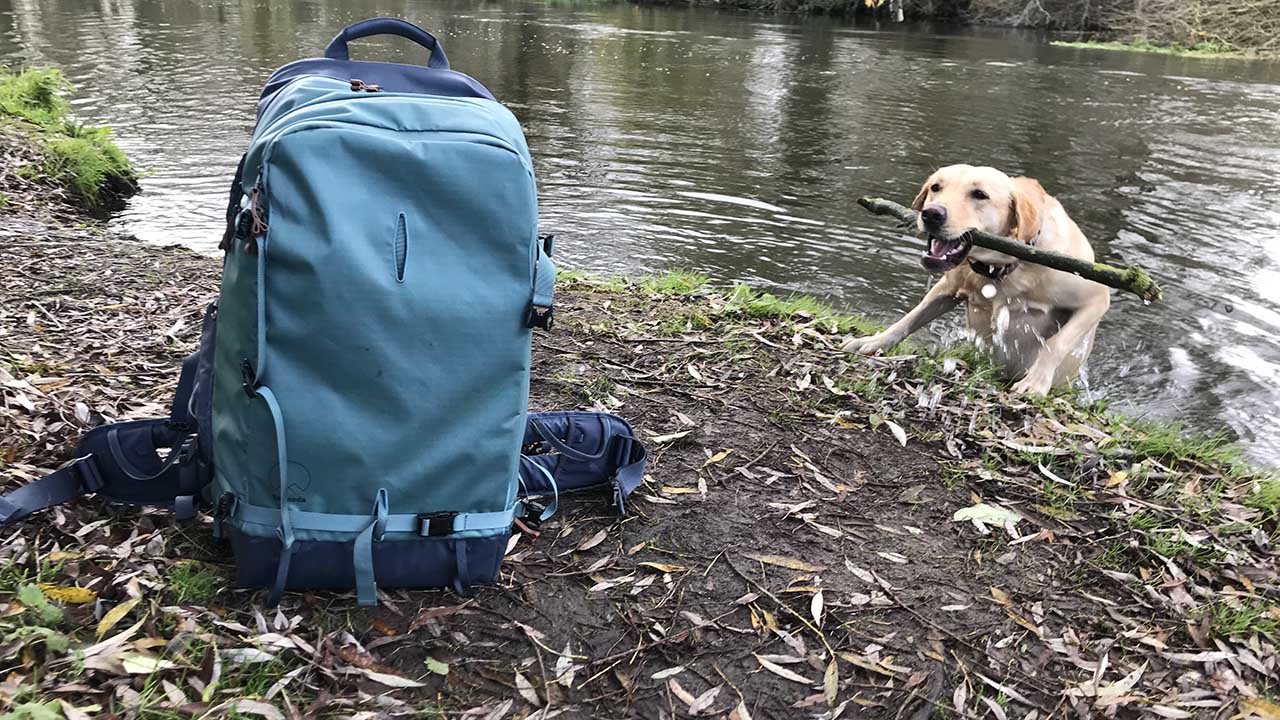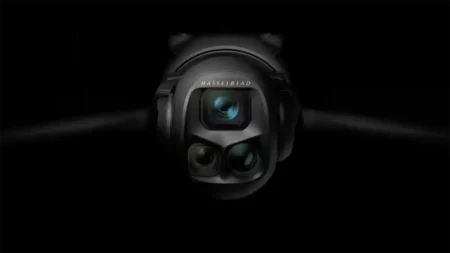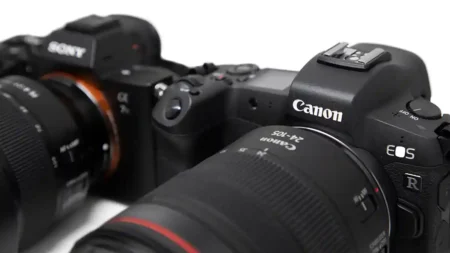Shimoda Explore 40L Backpack Snap verdict
The Explore 40L is a backpack for adventurers and explorers who need a no-fuss high-quality pack. Its design is simple, but there are two unique features, it has a fully modular design and customisable fit.
There a series of kits are available and you can configure the layout to your needs, be that kit storage, for air travel or full-blown adventure.
This is a no fuss to the design with no small outer pockets. Everything you need is contained within, but the way you configure the modules changes how the bag works.
Once you start to get into the bag, slots, cavities and internal mesh begin to reveal an inner complexity and versatility.
Pack the bag ready for flight with a couple of Sony A7 III’s along with three lenses, Benro Travel Angel and a few clothes, and you’re set for adventure.
Once you arrive, a quick switch around of the dividers and you can configure the inside as a large daypack with quick access to kit ready for use out on the trail.
There’s no doubt about the quality of the bag. And the options for customising the use all add to its value. The fit system is something new for a camera backpack with adjustments that enable you to get a perfect fit.
This is a bag that even when fully loaded, feels comfortable to carry, giving you a warm hug rather than just weighing you down.
The simplicity of design is one thing, but a small external pocket or two wouldn’t have gone amiss especially a pocket for a passport or memory cards.
Ultimately, an excellent bag designed for outdoor adventure rather than everyday strolls. It looks great and raises the standard when it comes to backpack comfort.
Introduction
Backpacks are coming thick and fast at the moment with an explosion of innovation that makes the task of choosing the right one harder than ever.
One of the bags that stands out for its style, design and quality is the Shimoda Explore 40L Backpack.
Available in two colours Blue Nights or Sea Pine, this professional level bag has enough space for a significant amount of kit and is an ideal choice for any jobbing and travelling photographer.
As the name suggests, it’s aimed at the outdoorsy, adventurous type who likes to travel. The bag design and features reflect this.
It’s a modular bag so you configure the inner as you see fit. This enables the bag to transform from kit transport mode to large-scale day or multi-day pack.
There’s plenty of innovation in the bag market at the moment, and the most successful bags seem to target a specific market. The Explore looks set to appeal to those photographers who travel and explore. Naturally, because of its size and design, it won’t suit all.
Features
The Shimoda 40L is very different from the mainstream of camera backpacks. This difference is evident from the outset with the bag being a bare-bones modular system.
The main backpack is precisely that, a pack. And it only transforms into a camera bag once the core units are installed.
There’s a good selection of core units available. These can be bought in predefined kits that bundle the right units together to fit the pack. They can be swapped and changed to suit your adventure.
Our 40L review kit is the Professional kit. This features two small and one medium core units and one medium accessory case.
Although the bag is simple, it features a large pocket on the front and another behind the rear access flap. The pocket on the rear of the flap is designed for a laptop up to 13-inches.
One of the significant features of the bag is the adjustable fit. This means that you can fine-tune the bag for ultimate comfort whatever your height.
The straps can be adjusted to suit your height with a small, medium, large and extra large option.
There’s also a large waist strap designed to take the weight of a fully loaded pack and a chest strap for additional comfort.
The bag is 29 x 57 x 26cm externally with an inner space of 29 x 44 x 17cm. As this bag is designed for travel, the outer dimensions have been carefully considered to fit most carry-on bag requirements.
Due to the high tech fabrics used in the bag, it weighs in at 1.3kg without any inserts. That’s not bad for a pack of this size.
Small Core Unit
The Small Core Unit will fit two small to medium sized lenses and a small to medium sized DSLR or CSC.
Each of the Small Core Units comes with a multi-purpose cover. This primary intended as a protective cover when the unit is in storage.
The small unit measures 29 x 13 x 17cm externally, with the inner dimension being a couple of centimetres smaller in each case.
The inner section can be divided with the internal velcro dividers to compartmentalise the space.
Medium Core Unit
The Medium Core Unit is the same width as the Small Core Unit which means that they slot neatly one on top of the other inside the bag. It has room for a camera body with 70-200mm fitted, a spare body and two additional lenses along with a few accessories.
The medium unit is 29 x 30 x 17cm externally and again 2cm small internally. Velcro inner divides divide space.
Medium Accessories Case
This small case can fit in the top of the pack and has space for extras such as filters, memory cards, lens caps or anything that needs to be kept neat and tidy.
The case is divided into two sections, one large mesh covered and the other divided into two zipped pockets, again with mesh covers.
There’s also a shoulder strap that can be attached which makes it useful in all sorts of situations.
The medium case is 29 x 15 x 8cm.
Pocket and slots around the pack
Although not at first obvious, there is a good selection of pockets and stash aways dotted around the bag.
On the shoulder straps, there’s a neoprene pocket which will hold a small water bottle or phone. Then on the side a large zipped pocket that contains the tripod pouch.
Inside the top section, there are two inner mesh pockets and on the front a large pocket that covers the entire front.
The more you use the bag, the more you discover.
Build quality and handling
When the Explore 40 arrives and before you start arranging the velcro dividers, you first need to assemble the bag.
Our review unit was the Professional Kit; this features the bag, two small and one medium core unit along with the accessories case.

After a little playing around with the configuration, I decided on the a small and medium in the central cavity and then the accessories case in the top.
A sizeable diagonal zip across the body enables you to access the full inner cavity so that the units can be popped in. Once zipped up and the bag is flipped over to the back, the back section can then be unzipped for access to the divided sections.
I realised as I was setting the configuration that in order to get side access I would need a third small core unit which would need to be placed on its side towards the opening.
As I only had two and to be honest wasn’t that bothered about the side access it wasn’t an issue, but just something to note.
Removing, moving and placing the inner divides took the usual amount of time, I have a habit of ripping them all out, laying out my kit inside and then seeing if I can layout the divides around my equipment.
Inevitably after a good hour of messing around, I’ll end up back to the rough configuration the bag arrived in. After this process, I do however feel more familiar with the bag and its workings.
Loading the kit in and those inner dividers feel thinner than most bags but at the same time have greater rigidity and all hold in place securely.
Once the camera kit is in, and memory cards, spare batteries, mics and cables are all put in the top section. The large top section has two zipped pockets on either side which are perfect for holding cables neatly.
Then stuffing in a Video lens to fully pack out the top and accessories case now in the side I’m ready for the off.
As I lift the bag, I’m fully aware that I may have slightly overloaded. I’m going to a location shoot and have packed in every piece of Sony Kit I own knowing that I have both stills and video to shoot.
I’ve also managed to use the two clip straps either side of the bag to attach two Benro M3 tripods. At present, the M3 is my stand out the tripod for many reasons, but foremost it’s solid – oh and one of them happens to be bright green.
In the side pocket there is a tripod pouch, but as I’m attaching two tripods I’m not using it in this instance.
Putting the backpack on is an effort due to the weight, a little too much kit, but after a slight struggle, it’s on.
I’m not just overloading to see how much I can fit, or for that matter lift, I’ve done this to test one very important feature.
That feature is the custom fit that this bag offers. There are a few manufacturers who take your physical size into account with the design of their bags.
Vanguard produces the excellent Vanguard Alta Sky 45D review, a great bag and one of the most comfortable on the market, but for me just a little short in the back, however upscale to the 51D, and I have a bag that’s a perfect fit.
Here Shimoda has been very clever, rather than offering a series of different models with different back lengths; you have just one model with the ability to adjust the shoulder straps top position.
Some other bags use compression straps to enable a similar amount of adjustment, but that never gets the back length 100% right, or at least not to the level of comfort felt here.
Adjusting the shoulder strap is easy enough, lay the bag on it’s front then at the top of each strap there’s a small zip which gives you access to the velcro loop that secures the strap in place.
Simply un-velcro, shift the strap up or down a slot and velcro back up. The design means that once in place and zipped up there’s no chance of the strap undoing by itself.
Bag weighted and adjusted it’s time to test out the comfort, admittedly the first hike with the bag on is only a few metres to the car, but the second hike is considerably further, and I’ll be wheeling a lighting kit.
Initial impressions of the comfort are staggering, it’s one of those items that once you pop it on you instantly want others to try. It is more than comfortable.
The straps themselves at the top don’t feel that padded, but when in place they help take the weight perfectly.
With the bag overladen and looking slightly ridiculous I arrived at the destination with about a mile to walk. Lugging the bag out of the car I very quickly decide a two journey approach is best, mainly due to the hard case with wheels that contains the lighting deciding it’s a wobbly day rather than a straight wheel down the road day.
Bag on and setting off with chest and waist strap buckled, and the backpack feels comfortable, hugging on tight. The comfort is like no other backpack with the fit feeling like a hug rather than hang off your shoulders.
Arriving at the destination I have to admit being slightly out of breath and in need of breakfast and coffee, but the bag did the job, overladen but comfortable enough to walk a distance.
Shoot over and the bag had through-out the day worked well. From storing the kit to the shoot to being a useful repository for storing and switching kit during the day.
One feature that worked well during the shoot was the back flap to access the kit. This folds all the way back and closes down nice and flat when needed.
This gives you a flat surface for a laptop when needed and proved very handy.
It’s a small but important feature that is often overlooked.
After the shoot
After this initial shoot, I continued to use the Explore 40 and a few other bags over a couple of months, each bag very quickly fell into the go-to bag for different situations.
The Shimoda became the out for a ride or all day hike bag. The central cavity holding my camera kit, and more kit than I would usually take because of the comfort. The top filled with food and dog treats and the side pocket, well let me tell you about the side pocket.
On the side is a huge pocket, you can stuff things in like the accessories case, but it also contains a removable side panel pouch. This is designed to take the legs of a tripod.
But it can also be removed from the side pocket and chest mounted where it then becomes a very handy camera pouch.
As you start to explore the bag fully you begin to see more of these features, small rubish pouches on the waist strap, a stretch neoprene pocket on the shoulder strap for a water bottle or walkie-talkie.
The large front pocket is ideal for all sorts of items including a large water bladder such as a platypus, or a large laptop, obviously not at the same time. I found the 15-Inch MacBook Pro was a perfect fit.
The back panel that sits against your back features an innovative design pattern that enables natural air flow. On the back of this access, flap is a slot for a 13-inch MacBook Pro.
At this time of year, rain is an issue, and one feature that I liked was the inclusion of YKK splash guard PU zippers. These help to keep the water out. They’re not waterproof, but during several heavy downpours, the bag kept all contents dry.
The nylon shell further enhances this water resistance.
The Shimoda Explore 40L is a large backpack, so while it was great on many occasions, its size meant that it is one to choose when you either need to carry quite a bit of kit or you’re off on an adventure.
Verdict
Over my time testing the bag, I was impressed by the material and build quality. All the zips, seams and buckles lived up to heavy use. And as the test progressed, the bag started to sustain the usual signs of wear that make the backpack feel like it has been properly bedded in.
The comfort for me was the real winner. The Vanguard Alta Sky 45D is comfortable, but this takes comfort to the next level. It’s also a heck of a lot more expensive.
That expense does buy you one of the best camera bags on the market, but it’s not an everyday pack, and it won’t suit everyone.
One of my most significant issues with the bag is there are no small outer pockets. I’d like somewhere to put a passport for example. Everything is neatly contained within.
There’s also the issue of the zipping system, the sizeable diagonal zip enables you to load in the core units, but unless you’re using the side access configuration, there’s no real reason for a zip to still be there. A small secure for the zips ends would also have been a nice addition.
Then there’s the side access. Firstly you need to buy the three small core units when you’re buying the system. They offer the Professional Kit but no kit that offers this configuration out of the box.
Once you have the three small core units which will set you back £120, you can lie two in the bag upright while the other lies down. I can’t fully check this as I don’t have the three small core units, but the one laying down is thinner than the two upright which means that there’s going to be a bit of wiggle space.
There’s no doubt that this bag is designed for outdoor use and for use by adventurous types.
I don’t explore anywhere exotic, but the New Forest is a great place to hike or ride for the day. It’s not pushing the boundaries on adventure, but the weather, mud, cows, pigs and horses can catch you out.
Ultimately, the Shimoda is the most comfortable backpack I’ve used that’s designed with exploring in mind. It’s designed for the outdoors, adventuring and exploring where it truly excels.
The size of the Explore 40 means that it’s a full day or multi-day pack, not a bag that you’d grab when walking the dog.
In the first part of the test, due to its size I used it as a kit carrier on a job, and I have to say it was good but not really what it was designed for.
As I used the bag, I found that soon the painstakingly divided kit sections mellowed, and energy bars, dog treats and bike tools started to fill the sections alongside my bare-bones camera kit. All divided and perfectly protected.
Rain jackets, towels and jumpers filled the top section, and before long it became the day hike bag for those days you set off without purpose to explore, have fun and take a picture or two.
For anyone who needs a bag for adventure and exploring then the Shimoda 40 is the bag for you.


